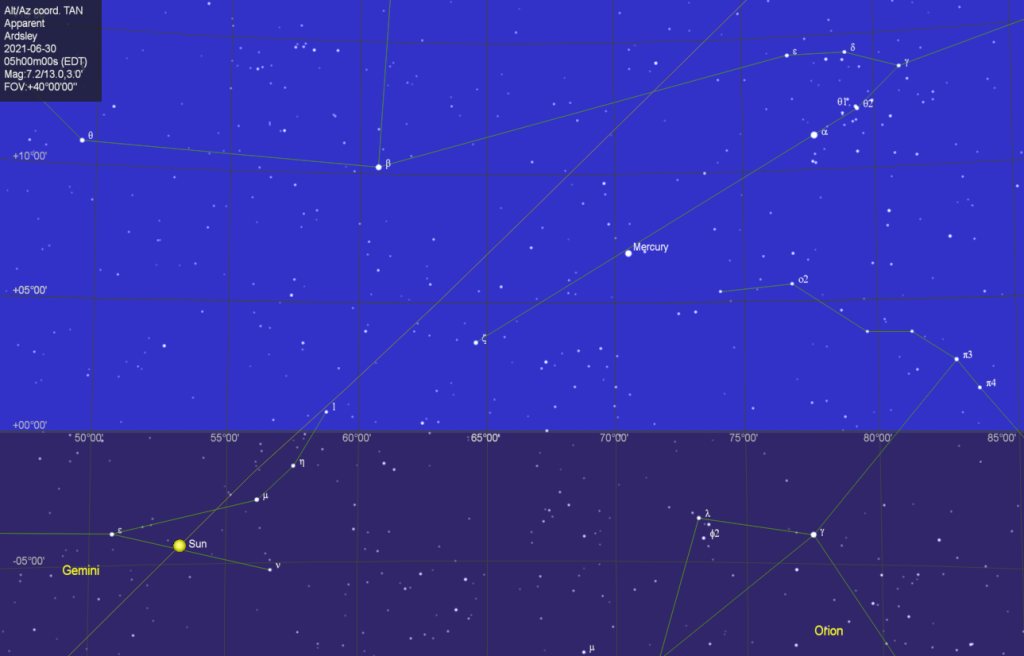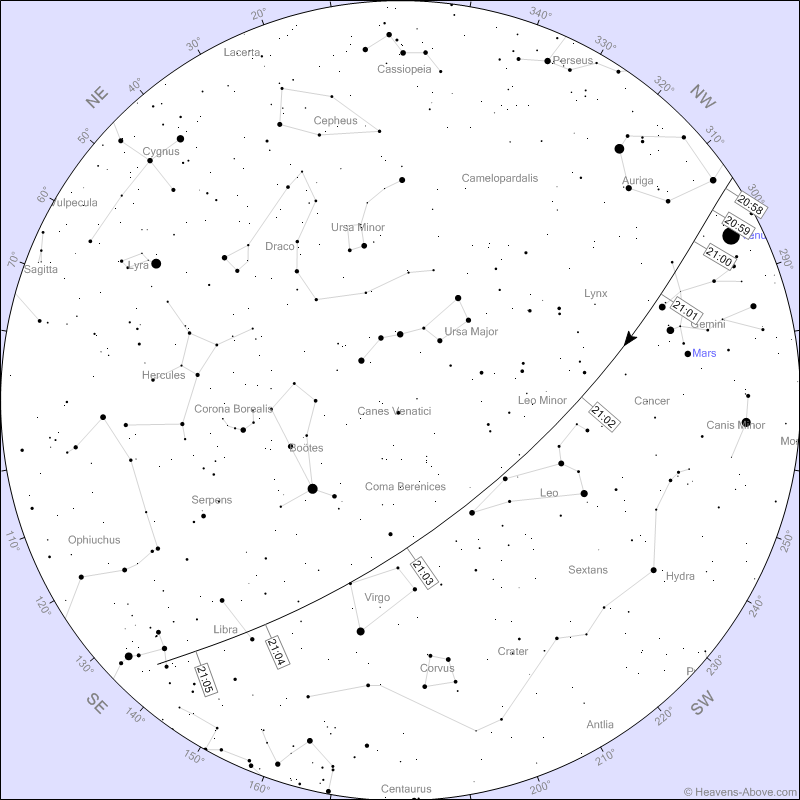The Big Event
Sunrise. Thursday. June 10. A horned Sun rising in the east-northeast. The next clear day before then, find a place where you can see all the way down to the horizon in the direction of an azimuth 58 degrees from north*. Sunrise will be at 5:24a.m. Maximum eclipse, with 75 percent of the Sun covered, is at 5:33, at only one degree above the horizon. It’s all over by 6:31, with a Sun only 10 degrees high. You can do this and still make the first-of-the-morning Zoom call for work. If you get out early (you can get a good spot, but check to see if the morning twilight looks weird, as the eclipse begins 46 minutes before sunrise. Atmospheric refraction could produce some fantastic mirage images at sunrise. I bet there will some early morning Metro North commuters who will be surprised to see a crescent Sun out their window if they get a gap in the skyline at the right time.

Scott, at Scott’s Sky Watch, notes how the trees, now in full leaf, can produce hundreds of tiny crescent Suns on a surface. So, don’t forget to look behind you! It would be quite a show to see all these partially eclipsed moons on a wall or other vertical surface, especially if they are dancing around your shadow.
Lovely Evening Views
Mars is a faint, pale version of the typically vibrant red planet we love. It’ll still be around for a couple of months, looking like an aircraft with a red tracking beacon gliding across the western sky on approach to the runway.
On the 23rd, Mars tries to hide in M44, the Beehive Cluster. Can you catch both in a photo? It’s hard to catch a magnitude +1.8 disk in the midst of minute flecks of sixth magnitude stars in one photo. See if the human eye can perceive it all.

Earlier, the 12 percent lit Moon photobombs Mars’ scene on the 13th. We’re in the time of year when the Moon passes M44 and doesn’t overwhelm it.

Can you see Castor and Pollux to the right of Mars by the 11th and to the right of Venus by month’s end?
Viewing Venus is like watching the launch of a mammoth liquid-fueled rocket. It struggles to gain altitude in the west northwest, but looks spectacular at magnitude -3.9 and 85 percent lit. It’s going to be around after sunset through the end of the year.
Outer Planet Lament
It’s mid-June, and Jupiter rises at – midnight! It’s going to take until August for the gas giants to rise by sunset. In the meantime, the best time for viewing Jupiter and Saturn will be after midnight, with Saturn leading the way, rising by 10:30p.m. by the end of June.
On the 27th and 28th, the Moon glides by, but well below, Saturn and Jupiter.

Inner Planet Ascent
Mercury hides in the solar glare, visible in the Solar & Heliospheric Observatory’s C3 viewer from the 5th through the 16th. The innermost planet may be visible at magnitude +1.0 by the end of the month low in the morning dawn part of the sky, rising by 4:30a.m. It’ll be easier to see from the southern hemisphere.

Does This Make Me a Supermoon?
The Moon reaches perigee 33 hours before June 24th’s full Moon. It continues the trend for the lunar monthly perigee moving farther from the time of full Moon. The lunar apogee on the 7th is a reason for the annular, rather than total, eclipse on the 10th.
Satellites
We have the shortest dark nights of the year, but because the Sun doesn’t get too far below the horizon, satellites can be visible most any time of the night. The International Space Station is in the evening sky only though the 4th. Can you catch it when it rises near Venus? The ISS will be much fainter when it’s that low in the sky. Peak brightness is overhead. This long-running human outpost in space will be visible in the morning sky starting on 25th.

Castoff Pieces of Ice and Rock
The brightest comet (so far) for June is 2020 T2 (Palomar), which might brighten a bit from magnitude +10.5. It’s between Boötes and Virgo. Prospects for 2021 A1 (Leonard) are dimming a bit. There are hopes for Leonard to be a magnitude +4 comet in the morning sky by the end of the year. The British Astronomical Association’s Comet Section says electronic observations are showing a fainter than expected comet. Even if it’s magnitude now is only +17.5, it’s still early.
June is a quiet month for meteors, with no major showers. Maybe because of the lack of darkness, no one has noticed.
Views of Our Galaxy
The rising of Scorpius in the southeast heralds the return of the Milky Way arcing across the east after astronomical twilight ends just after 10p.m. You’ll need a very dark location, away from urban and suburban lights, to see it when it is so low in the sky.
Summer!
The solstice occurs, with the Sun at its highest declination north, at 11:32p.m. EDT on the 20th. The latest sunset at mid-latitudes is on the 27th.
*Data are for White Plains, New York. If you use a compass to find a clear azimuth, don’t forget to adjust for magnetic declination. (13 degrees west of true north.)
Spotting the Sun 1º above the horizon is a big ask for most people. I hope you get to see it!
LikeLiked by 1 person
Well, we did it! Sadly, wordpress says I’m out of space. So the photos are on facebook.
LikeLike